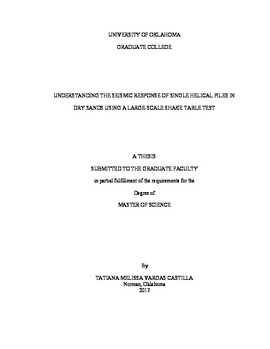| dc.description.abstract | Helical piles are deep foundations composed by a steel shaft and single or multiple helical plates welded at their tip or throughout their lead section, respectively, which allows them to be screwed into the ground during installation, producing minimum vibration and fewer soil disturbance compared with other type of deep foundations; moreover, their helixes provide extra resistance or bearing capacity to the piles, enhancing their uplift and compression behaviors. This type of pier has been widely implemented in seismically active areas of New Zealand. Nevertheless the use of screw anchors is restricted to non-earthquake prone areas within the United States territory, mainly due to the lack of a quantitative prof that demonstrates their performance under earthquake loadings or even more, that compares their seismic performance with other types of foundations. According to the United States Geological Survey statistics, the number of earthquakes within the US territory is increasing. Moreover the Federal Emergency Management Agency reported that the US annualized earthquake loss was $5.3 billion in 2008. A demand is then posed to improve current foundations’ resilience or dynamic performance and to propose other alternatives to mitigate future earthquake damages. This research aims to determine the dynamic response of helical piles embedded in dry sand subjected to lateral seismic loadings using the largest U.S. shake table located at the University of California-San Diego. Furthermore, it attempts to identify the difference between the performance of a helical pile and an equivalent driven pile under earthquake events, in addition to quantifing the influence of the number of helices and shaft geometry on the overall seismic resistance of the helical pile. To that end, two full-scale tests were conducted in eight single helical piles (four with 5.5” outside diameter (O.D.) and four 3.5” O.D.), one double helical pile with 3.5” O.D. and one 3.5” O.D. driven pile, embedded in dense, dry sand up to a depth of 11 feet. Each pier was instrumented with strain gages throughout its shaft length to calculate bending moments and axial loading. Moreover the sand bed, laminar box and pile heads were instrumented with accelerometers. Two conditions were evaluated: piles with free head and piles supporting inertial weights on top, for each stage, two major earthquakes were replicated: the Takatori-Kobe of 1995 and the Northridge 1994, under 100%, 75% and 50% amplitudes. During each shake, videos and photos were taken to register the soil-pile interaction and a DCP test was conducted on the sand bed before and after shaking. The results show that the dynamic performance of the piles was primarily influenced by their natural frequency. For the frequency range tested (0.5 to 5 Hz) and up to a peak acceleration of 0.67g, it was found that the single helical pile presented a stiffer behavior compared with the double helical pile, which may be attributed to the higher soil disturbance produced during the installation of the double helical pile. In addition, under ground motions characterized by a low frequency content (up to 1.5 Hz), the square-shaft helical pile outperformed the response of the circular-shaft helical pile for all the accelerations tested. Finally, under seismic conditions, a hysteretic reduction of the damping response of single helical piles with respect to the depth of the soil was observed. | en_US |
